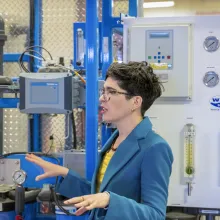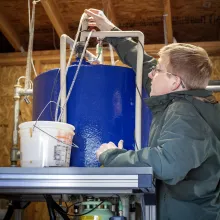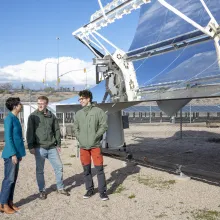More Circularity, Less Drain: UArizona and SRP Collaborate to Improve Sustainability of Data Centers

Photo by Leslie Hawthorne Klingler
Kerri Hickenbottom, Assistant Professor in the College of Engineering and researcher at WEST Center, is working with the Salt River Project (SRP) to explore innovative ways for data centers to operate while reducing water and energy consumption. Dr. Hickenbottom points out that the water and energy needed to process digital activities is significant. “Data centers require tremendous amounts of water and energy,” she says. “If we can change that, we’ll make a real impact.”
Dr. Hickenbottom runs the Hickenbottom Environmental Research (HER) Lab group at the University of Arizona, and is grateful for an ally in her work to bring circularity to our water-energy systems. SRP is a not-for-profit utility company that supplies water and electric power to approximately two million people in central Arizona. SRP collaborates with university researchers to meet its sustainability goals and address other issues important to the company and its customers, which include water and energy sourcing, use, and conservation. Dr. Hickenbottom is in year four of her collaboration with SRP.
What’s so special about the UArizona–SRP partnership?
Dr. Hickenbottom: I’ve been working with Salt River Project for four years. SRP is unique in providing both water and energy, and they have a significant presence in the state. Our collaboration has to do with conserving water in data centers. Because of its proximity to extensive fiber optic networks, low energy costs, and minimal risk for natural disasters, Phoenix is set to become the second largest data center hub in the U.S., next to Ashburn in northern Virginia. The computing capacity that data centers in this region can provide is enormous, and there’s an excellent opportunity to make a difference.
It’s been rewarding and fun working with SRP. They want to see economic prosperity in their region, and they’re trying to figure out ways to balance resource availability with demands. With so many large industries wanting to come to Phoenix, the company needs ingenuity to be as efficient as possible with water and energy resources. They don’t want to turn industry away because these resources are lacking.
Why did you and SRP decide to focus research on data centers?
Dr. Hickenbottom: We started with data centers because they consume a lot of water and electricity, and more and more of them are being built in Arizona. The total energy consumption in our nation’s data centers in 2006 was approximately 61 TWh—the equivalent amount of energy used by 7.1 million four-person homes! In addition, about 2.4 gallons of water are used per every kWh of energy produced. Do the math—that’s billions of gallons of water!

Dr. Hickenbottom conducts water-energy nexus research in collaboration with SRP
My work has been looking at different data center cooling systems and measuring their energy and water footprints. There’s always a trade-off between water and energy. The cooling systems that use a lot of energy generally use less water. On the other hand, if you use a lot of water, you’re likely spending less energy on that cooling system. We’re looking at the interplay between water and energy in these systems and alternative water sources on- or offsite that could be used for data center cooling.
The dependence on water in cooling systems and the critical role of the water-energy nexus have been largely overlooked. A big reason for this oversight is that data center energy costs are typically much more than water costs because water is priced so low. The cooling process accounts for upwards of 40 percent of data center energy use. If you’re looking at a data center’s energy bill compared to its water bill, it’s greater in order of magnitude—millions versus thousands. So it makes sense that the industry focus has been to develop less energy-intensive cooling systems, even if they use a lot of water.

Student, Jeb Shingler, works on a water research project near the WEST Center in Tucson, AZ
The thing is, what is the actual cost of the water that data centers use? And what if prices start to reflect water’s real value? Right now, you can get away with using a lot of this resource at little cost, but this isn’t going to last.
What are you and SRP hoping to develop for data centers?
Dr. Hickenbottom: Currently, potable water—tap or well water—is used for cooling at many sites. But data centers probably don’t need such high-quality water. It would be great if they could use alternative sources such as reclaimed water or practice onsite water reuse for the existing cooling systems. In most cases, it would be silly to replace existing cooling systems because such an extensive infrastructure is costly. It would be more helpful to figure out how to squeeze more drops of water from what they already have.
Our goal is to develop tools and resources, so data center decision-makers know how cooling system selection impacts not only their energy demands but also their water footprint. We want to give them options to consider based on regional conditions and resource availability and help them make well-informed decisions.
What is the best part of your collaboration with SRP?
Dr. Hickenbottom: This work is meaningful and fun because our collaborators at SRP are so engaged. They provide excellent feedback and access to information that makes our science relevant to a broader audience. Since SRP is client-based, they always want to know how their investments benefit their clients. With this collaboration, we’re challenged to communicate our research to real stakeholders.
You’ve said you like tangible results. What tangible results are you achieving with SRP?
Dr. Hickenbottom: We’ve developed a multi-criteria decision support tool for stakeholders to assess how cooling system selection and data center operation impact their water and energy consumption. The stakeholder will input their IT load, or how much energy their server equipment currently uses, and rank what’s important to them—factors like reliability, maintenance, ease of use, water use, and cost. They’re prompted to submit ten or so different inputs, then they can run simulations to tell them, for example, the water usage for the nine different types of traditional cooling systems they’re considering. They can also see how much energy each option uses and how the cooling systems rank in terms of reliability and maintenance. This past year, we’ve been working on expanding the decision support tool to include the potential for onsite water and energy reuse.
Our tool is open source and the first of its kind. The multi-criteria decision support tool for data centers is now available online:
DC E-WISE: Data Center Energy and Water Information Simulator and Evaluator
We’ve been fortunate to connect with SRP and do beta testing with some of their clients. This is providing us with valuable feedback from the data center industry.
As we finish this research, we’re talking with SRP about how our decision support tool can be expanded and commercialized for other commercial, industrial, and institutional facilities. The tool could be adapted to serve a much larger community, to different kinds of clients like hospitals and universities. As a step toward this, one of my research colleagues is packaging the decision support tool to turn it into an attractive, user-friendly app.
We’ve also developed white pages that SRP can present to new data center customers to show them some of the research they’ve been investing in. The white pages communicate our findings in an abbreviated and graphical format about the water and energy trade-offs associated with the cooling systems they’re considering.
What concluding thoughts do you have for us?
Dr. Hickenbottom: We are all starting to think more about how connected and reliant we are on technology and the cloud. However, we don’t necessarily make the connection that cloud computing uses resources. Cyber mining is mining. Everything we do online uses servers that consume energy and water and creates waste. Because data centers need to be reliable and secure, they have backups. And so it’s not just one server housing your data that’s stored on the cloud; it’s probably at least two servers. Do we really need everything on the cloud? Do we need to be getting data all the time? All that digital computing comes at a physical cost to our resources.

UArizona's Kerri Hickenbottom, Jeb Shingler, and Marco Malaguti visit a solar heat experiment site. The site provides opportunities to study the use of heat energy in water purification processes.
A while ago, I toured the National Renewable Energy Lab. They have their own high-performance computing center onsite. I asked what happens to all their server racks. Those racks are made from all kinds of metals mined and separated through physical and chemical processing which uses lots of energy and water resources, and each server rack weighs between one to six tons. The servers last about two years before needing to be replaced because of technology improvements and changes. Do you know what happens to the old servers? If they are not surplussed for other uses, they go straight to the landfill.
We all do the same thing on a smaller scale with our phones, computers, and other things we buy. The technology we discard doesn’t just disappear into thin air; it goes somewhere else. Nothing really goes away. There is much work to do before our systems show positive circularity.
Thanks for your excellent work and for taking the time to share it with the Arizona community.
Dr. Hickenbottom: Thank you!

